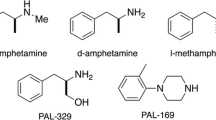Abstract
Reinforcing effects of the (+)- and (-)-enantiomers of N,N-dimethylamphetamine, a drug that is abused in humans, were studied in squirrel monkeys(Siamiri sciureus) trained under schedules of intermittent cocaine reinforcement. During training, each 30th response produced an injection of cocaine (fixed-ratio schedule), which was followed by a 1-min period during which lights were out and responses had no scheduled consequences (timeout). Sessions in which cocaine injections were scheduled alternated in an irregular sequence with sessions in which saline injections were scheduled. After training, response rates were well maintained by cocaine (response rates approximated 1.4 responses per second) but occurred relatively infrequently during sessions in which saline was injected (response rates approximated 0.3 responses per second). Doses of 10 to 56 µg/kg/injection of (+)-N,N-dimethylamphetamine maintained rates of responding significantly higher than those maintained by saline. The (-)-enantiomer did not maintain rates of responding that were higher than those maintained by saline when tested at doses up to 100 µg/kg/injection. These findings support previous results indicating that N,N-dimethylamphetamine will function as a reinforcer in laboratory animals. Further, they suggest that the significant reinforcing activity of this drug is restricted to the (+)-enantiomer.
Similar content being viewed by others
References
Barrett JE (1985) Behavioral pharmacology of the squirrel monkey. In: Rosenblum LA, Coe CL (eds) Handbook of squirrel monkey research. Plenum Press, New York, pp 315–348
Ferris RM, Tang FLM, Maxwell RA (1972) A comparison of the capacities of isomers of amphetamine, deoxypipradrol and methylphenidate to inhibit the uptake of tritiated catecholamines into rat cerebral cortex slices, synaptosomal preparations of rat cerebral cortex, hypothalamus and striatum and into adrenergic nerves of rabbit aorta. J Pharmacol Exp Ther 181:407–416
Finney DJ (1964) Statistical methods in biological assay, 2nd edn. Hafner, New York
Glennon RA (1991) Phenylalkylamine stimulants, hallucinogens, and designer drugs. NIDA Res Monogr 105:154–160
Graham BE, Cartland GF, Woodruff EH (1945) Phenyl propyl and phenyl isopropyl amines. Changes in pharmacological action on substitution of phenyl nucleus and amino nitrogen. Ind Eng Chem 37:149–151
Hake DF, Azrin NH (1963) An apparatus for delivering pain shock to monkeys. J Exp Anal Behav 6:297–298
Heikkila RE, Orlansky H, Mytilineou C, Cohen G (1975) Amphetamine: evaluation ofd- andl-isomers as releasing agents and uptake inhibitors for3H-dopamine and3H-norepinephrine, in slices of rat neostriatum and cerebral cortex. J Pharmacol Exp Ther 193:47–56
Herd JA, Morse WH, Kelleher RT, Jones LG (1969) Arterial hypertension in the squirrel monkey during behavioral experiments. Am J Physiol 217:24–29
Katz JL (1982) Rate-dependent effects ofd- andl-amphetamine on schedule-controlled responding in pigeons and squirrel monkeys. Neuropharmacology 21:235–242
Klein M (1989) Public health risks resulting from processing impurities in clandestine drugs. In: Klein M, Sapienza F, McClain H Jr, Khan I (eds) Clandestinely produced drugs, analogues and precursors: Problems and solutions. US Government Printing Office, Washington, DC, pp 175–193
Ricaurte GA, DeLanney LE, Irwin I, Witkin JM, Katz JL, Langston JW (1989) Evaluation of the neurotoxin potential of N,N-dimethylamphetamine: an illicit analog of methamphetamine. Brain Res 490:301–306
Risner ME (1975) Intravenous self-administration ofd- andl-amphetamine by dog. Eur J Pharmacol 32:344–348
Sapienza F (1990) Personal communication, Office of Diversion Control, Drug Enforcement Administration, US
Scheel-Kruger J (1972) Behavioral and biochemical comparison of amphetamine derivatives, cocaine, benztropine and tricyclic antidepressant drugs. Eur J Pharmacol 18:63–73
Simpson LL (1975) Blood pressure and heart rate responses evoked byd- andl-amphetamine in the pithed rat preparation. J Pharmacol Exp Ther 193:149–159
Snedecor GW, Cochran WG (1967) Statistical methods, 6th ed. Iowa State University Press, Ames, Iowa, pp 135–171
Tilson HA, Sparber SB (1973) The effects ofd- andl-amphetamine on fixed-interval and fixed-ratio behavior in tolerant and non-tolerant rats. J Pharmacol Exp Ther 187:372–379
van der Ark AM, Theewen AB, Verweij AM (1978) Impurities in illegal amphetamine. Arch Kriminol 162:171–175
Witkin JM, Ricaurte GA, Katz JL (1990) Behavioral effects of N-methylamphetamine and N,N-dimethylamphetamine in rats and squirrel monkeys. J Pharmacol Exp Ther 253:466–474
Yokel RA, Pickens R (1973) Self administration of optical isomers of amphetamine and methylamphetamine by rats. J Pharmacol Exp Ther 187:27–33
Young R, Glennon RA (1986) Discriminative stimulus properties of amphetamine and structurally related phenalkylamines. Med Res Rev 6:99–130
Zaczek R, Culp S, De Souza EB (1991) Interactions of [3H]-amphetamine with rat brain synaptosomes. II. Active transport. J Pharmacol Exp Ther 257:830–835
Author information
Authors and Affiliations
Rights and permissions
About this article
Cite this article
Katz, J.L., Ricaurte, G.A. & Witkin, J.M. Reinforcing effects of enantiomers of N,N-dimethylamphetamine in squirrel monkeys. Psychopharmacology 107, 315–318 (1992). https://doi.org/10.1007/BF02245154
Received:
Revised:
Issue Date:
DOI: https://doi.org/10.1007/BF02245154




